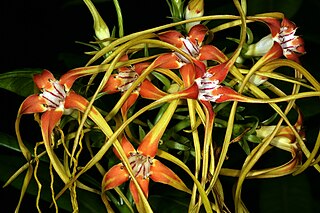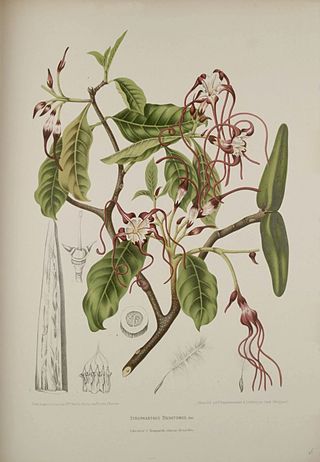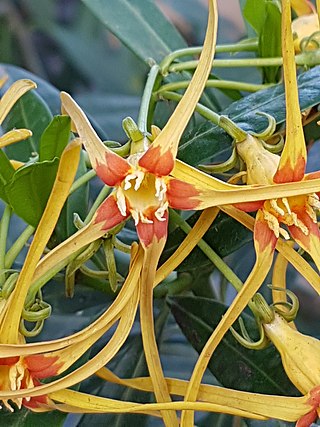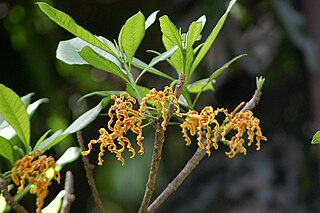
Apocynaceae is a family of flowering plants that includes trees, shrubs, herbs, stem succulents, and vines, commonly known as the dogbane family, because some taxa were used as dog poison. Members of the family are native to the European, Asian, African, Australian, and American tropics or subtropics, with some temperate members. The former family Asclepiadaceae is considered a subfamily of Apocynaceae and contains 348 genera. A list of Apocynaceae genera may be found here.

Strophanthus is a genus of flowering plants in the family Apocynaceae, first described as a genus in 1802. It is native primarily to tropical Africa, extending to South Africa, with a few species in Asia from southern India to New Guinea and southern China. The genus name is a compound of the Greek words στροφος (strophos) "twisted" and ανθοσ (anthos) "flower", in reference to the corolla lobes which, in some species - notably S. petersianus - resemble long twisted ribbons or threads and can reach a length of 30–35 cm. This trait, in addition to colouring involving combinations of bright pinks, purples and oranges, combine to make the flowers among the most ornamental in the plant kingdom.
The Aïna River is a tributary of the Ivindo River that rises in Cameroon. Along the way it forms the border between Cameroon and Gabon and then the border between Gabon and Republic of the Congo (Map.).

k-Strophanthidin is a cardenolide found in species of the genus Strophanthus. It is the aglycone of k-strophanthin, an analogue of ouabain. k-strophanthin is found in the ripe seeds of Strophanthus kombé and in the lily Convallaria.

Strophanthus kombe, the kombe arrow poison, is a vine that grows in the tropical regions of Eastern Africa, and is part of the genus Strophanthus, which contains approximately 38 species. S. kombe contains a cardiac glycoside which directly affects the heart. Historically, both the seeds and roots of the plant were used in the preparation of poison arrowheads used for hunting. Today, the seeds are used pharmaceutically for patients with certain heart conditions that affect blood circulation. The seeds are traded primarily with Europe, but have also been exported to the United States and Japan.

Strophanthus caudatus is a woody liana that can grow up to 12 metres (40 ft) in length, with a trunk diameter of up to 1.5 centimetres (0.6 in). It grows natively from Guangxi in southern China, through Indochina to Malesia and New Guinea.

Strophanthus divaricatus is a liana or sarmentose shrub that can grow up to 4.5 metres (15 ft) tall, with a trunk diameter of up to 4 centimetres (1.6 in). Divaricatus is from the Latin meaning "spreading at a wide angle". The plant has been used medicinally: as a heart stimulant and in the treatment of snakebites. It is native to southern China and northern Vietnam.

Strophanthus gratus is a plant in the dogbane family Apocynaceae.

Strophanthus hispidus, the hispid strophanthus, is a liana or shrub that can grow up to 5 metres (16 ft) tall. Its flowers feature a yellow corolla and yellow corona lobes spotted with red, purple or brown. The seeds, like those of several other Strophanthus species, contain potent cardiac glycosides absorbable through wounds - hence its use in African arrow poisons and later in modern medicine as a digitalis-like heart stimulant. Strophanthus hispidus is native from west tropical Africa east to Tanzania and south to Angola. It is naturalized in China.

Strophanthus petersianus, commonly known as sand forest poison rope, is a liana or deciduous shrub up to 15 metres (50 ft) long, with a stem diameter up to 10 centimetres (4 in). Its fragrant flowers feature a white corolla, sometimes with reddish pink stripes on the inside. Strophanthus petersianus has been used as arrow poison and by the Zulu as a charm against evil. Its habitat is coastal forest and rocky woodland. It is native to countries from Kenya south to South Africa.

Strophanthus preussii, the Preuss' strophanthus, is a plant in the dogbane family Apocynaceae.

Strophanthus sarmentosus grows as either a deciduous shrub or as a liana up to 40 metres (130 ft) long, with a stem diameter up to 15 centimetres (6 in). Its fragrant flowers feature a white to purple corolla, red or purple-streaked on the inside. Strophanthus sarmentosus is native from west and central tropical Africa to Uganda and Angola. Vernacular names for the plant include spider tresses and poison arrow vine. Its habitat is forested areas from sea level to 1,400 metres (4,600 ft) altitude.

Strophanthus speciosus, commonly known as the forest poison rope, is a tree, shrub or woody climber which is native to southern Africa.
Strophanthus thollonii, or Thollon's strophanthus, is a plant in the dogbane family Apocynaceae.
Strophanthus welwitschii grows as a deciduous shrub or small tree up to 5 metres (16 ft) tall, or as a liana up to 8 metres (26 ft) long, with a stem diameter up to 10 centimetres (4 in). Its fragrant flowers feature a white turning purple corolla, creamy and red or purple-streaked on the inside. Its habitat is forests or rocky woodlands from 300 metres (1,000 ft) to 1,800 metres (6,000 ft) altitude. S. welwitschii is used in local medicinal treatments for respiratory conditions, gonorrhoea and scabies. The plant has been used as arrow poison. Strophanthus welwitschii is native to Democratic Republic of Congo, Tanzania, Angola and Zambia.

Strophanthus amboensis is a plant in the dogbane family Apocynaceae.

Strophanthus boivinii, the wood shaving flower, is a species of plant in the family Apocynaceae.

Strophanthus courmontii grows as a deciduous liana up to 22 metres (72 ft) long or as a shrub up to 4 metres (13 ft) tall, with a stem diameter up to 10 centimetres (3.9 in). Its fragrant flowers feature a white turning red and purple corolla tube, yellow with purple streaks inside. Habitats are forests and riverine thickets, from sea level to 1,400 metres (4,600 ft) altitude. S. courmontii is used in local medicinal treatments for rheumatism and as an aphrodisiac. The plant is native to Kenya, Tanzania, Malawi, Mozambique, Zambia and Zimbabwe.

Strophanthus eminii is a species of flowering plant in the Apocynaceae family. It is referred to by the common name Emin's strophanthus, and grows as a liana up to 10 metres (33 ft) long or as a shrub or small tree up to 7 metres (23 ft) tall, with a stem diameter up to 6 centimetres (2.4 in). Its fragrant flowers feature a pink with white turning red corolla tube, white turning yellow with red spots and streaks inside. Vernacular names for the plant include "spider tresses" and "poison arrow vine". Its habitat is deciduous woodland or rocky bushland, from 600 metres (2,000 ft) to 1,650 metres (5,400 ft) altitude. Strophanthus eminii is used in local medicinal treatments for snakebites, skin diseases and wounds and also as an anthelmintic. The plant has been used as arrow poison. It is native to Democratic Republic of Congo, Tanzania and Zambia.
Strophanthus nicholsonii grows as a deciduous scrambling shrub. Its fragrant flowers feature corolla lobes ending in tails up to 10 centimetres (3.9 in) long. Habitats are mopane woodlands, from 400 metres (1,300 ft) to 1,100 metres (3,600 ft) altitude. The plant is native to Malawi, Mozambique, Zambia and Zimbabwe.















